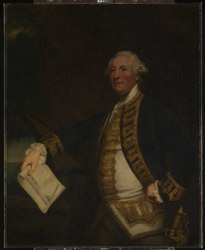File:Commodore Sir William James, 1722-83 RMG BHC2801.tiff

Original file (5,121 × 6,252 pixels, file size: 91.6 MB, MIME type: image/tiff)
Captions
Captions
Summary
[edit]| Joshua Reynolds: Commodore Sir William James, 1722-83
|
||||||||||||||||||||||||
|---|---|---|---|---|---|---|---|---|---|---|---|---|---|---|---|---|---|---|---|---|---|---|---|---|
| Artist |
|
|||||||||||||||||||||||
| Title | ||||||||||||||||||||||||
| Object type |
painting object_type QS:P31,Q3305213 |
|||||||||||||||||||||||
| Genre |
portrait |
|||||||||||||||||||||||
| Description |
English: Commodore Sir William James, 1722-83 A three-quarter-length portrait to left in the full-dress uniform of Commodore of the Bombay Marine. Wearing a white wig, he leans on an anchor fluke and holds a drawing of a fort in his right hand. In 1747 James joined the service of the East India Company and became Commodore of its marine forces four years later. He was chiefly concerned with the powerful pirate, Angria, whose stronghold of Severndroog he captured in 1755 and then assisted Watson and Clive in the capture of Geriah in the following year. The drawing that he holds in his hand is thought to be the fortress of Severndroog. He came home in 1759 and later became Chairman of the Directors of the East India Company. He was created a baronet in 1778. This is a documented studio replica, painted for the sitter's widow in 1784 from the original at Trinity House. The Trinity House version was begun in 1780 and completed in 1782 but was destroyed during the Second World War. In 1740 Reynolds was apprenticed to the portrait painter Thomas Hudson (1701-90) and after early work in his native Devon travelled to Italy in 1749. In 1753 he set up in London and rapidly began to make a name as portrait painter, profoundly influenced by his time in Italy. He became the first President of the Royal Academy in 1768 and was knighted in 1769. He was the most influential figure of the century in elevating British painting and portraiture. Reynolds borrowed poses from the old masters and by 1759 he had created social portraits in a new style that were deemed fresh and modern, and yet dignified the status of the sitter. |
|||||||||||||||||||||||
| Date |
1784 date QS:P571,+1784-00-00T00:00:00Z/9 |
|||||||||||||||||||||||
| Medium |
oil on canvas |
|||||||||||||||||||||||
| Dimensions | Painting: 1270 mm x 1015 mm; Frame: 1527 mm x 1273 mm x 105 mm | |||||||||||||||||||||||
| Collection |
institution QS:P195,Q7374509 |
|||||||||||||||||||||||
| Current location | ||||||||||||||||||||||||
| Accession number |
BHC2801 |
|||||||||||||||||||||||
| References | ||||||||||||||||||||||||
| Source/Photographer | http://collections.rmg.co.uk/collections/objects/14274 | |||||||||||||||||||||||
| Permission (Reusing this file) |
The original artefact or artwork has been assessed as public domain by age, and faithful reproductions of the two dimensional work are also public domain. No permission is required for reuse for any purpose. The text of this image record has been derived from the Royal Museums Greenwich catalogue and image metadata. Individual data and facts such as date, author and title are not copyrightable, but reuse of longer descriptive text from the catalogue may not be considered fair use. Reuse of the text must be attributed to the "National Maritime Museum, Greenwich, London" and a Creative Commons CC-BY-NC-SA-3.0 license may apply if not rewritten. Refer to Royal Museums Greenwich copyright. |
|||||||||||||||||||||||
| Identifier InfoField | Acquisition Number: 1934-16 id number: BHC2801 |
|||||||||||||||||||||||
| Collection InfoField | Oil paintings | |||||||||||||||||||||||
Licensing
[edit]|
This is a faithful photographic reproduction of a two-dimensional, public domain work of art. The work of art itself is in the public domain for the following reason:
The official position taken by the Wikimedia Foundation is that "faithful reproductions of two-dimensional public domain works of art are public domain".
This photographic reproduction is therefore also considered to be in the public domain in the United States. In other jurisdictions, re-use of this content may be restricted; see Reuse of PD-Art photographs for details. | |||||
File history
Click on a date/time to view the file as it appeared at that time.
| Date/Time | Thumbnail | Dimensions | User | Comment | |
|---|---|---|---|---|---|
| current | 00:54, 5 October 2017 |  | 5,121 × 6,252 (91.6 MB) | Fæ (talk | contribs) | Royal Museums Greenwich Oil paintings (1784), http://collections.rmg.co.uk/collections/objects/14274 #2351 |
You cannot overwrite this file.
File usage on Commons
The following 2 pages use this file:
File usage on other wikis
The following other wikis use this file:
Metadata
This file contains additional information such as Exif metadata which may have been added by the digital camera, scanner, or software program used to create or digitize it. If the file has been modified from its original state, some details such as the timestamp may not fully reflect those of the original file. The timestamp is only as accurate as the clock in the camera, and it may be completely wrong.
| Width | 5,121 px |
|---|---|
| Height | 6,252 px |
| Bits per component |
|
| Compression scheme | Uncompressed |
| Pixel composition | RGB |
| Image data location | 140 |
| Number of components | 3 |
| Number of rows per strip | 6,252 |
| Bytes per compressed strip | 96,049,476 |
| Data arrangement | chunky format |


